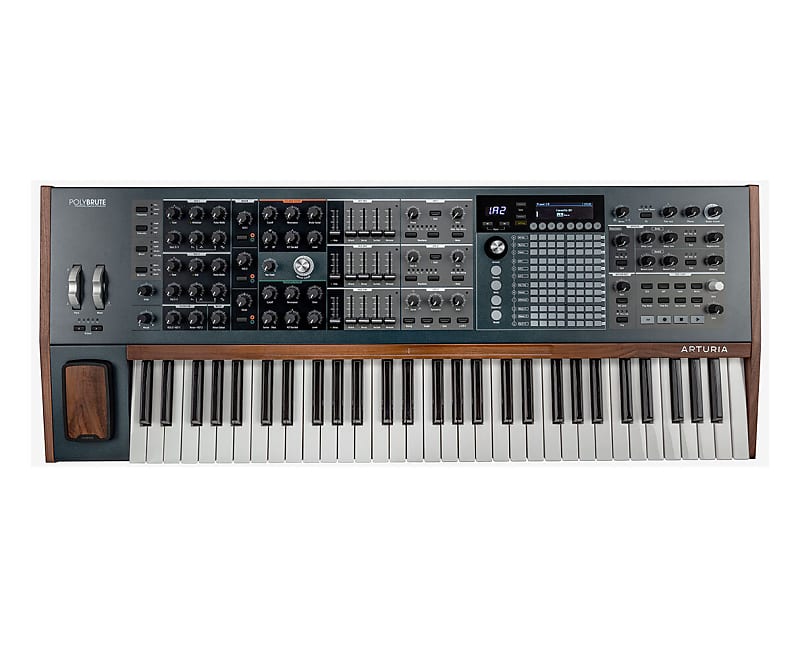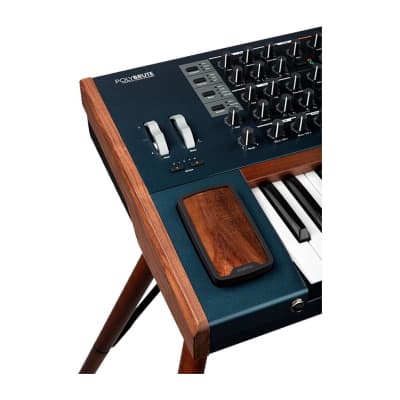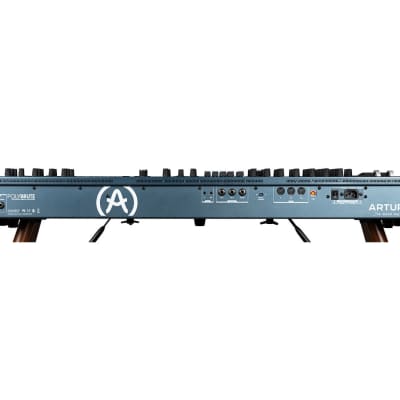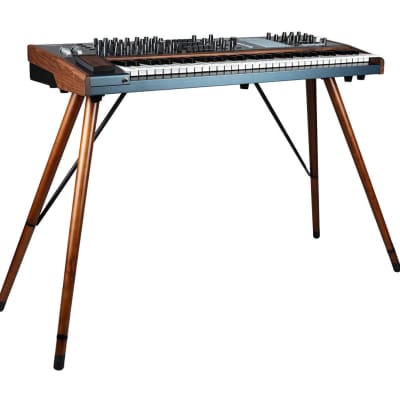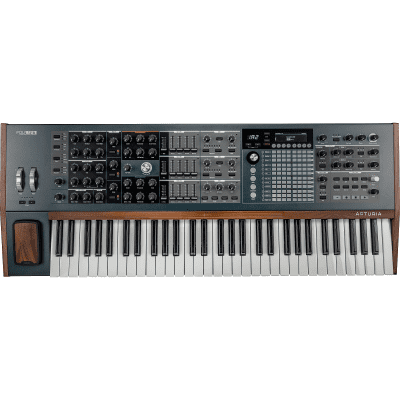Unsubstantiated speculation about an Arturia polysynth based upon the 'Brute' architecture has been flying around since the MiniBrute appeared in 2012, and with increasing intensity after the launch of the MatrixBrute in 2016. But while the company said nothing on the matter and continued to flood the world with soft synths, monosynths, plug‑ins, MIDI controllers, drum machines and audio interfaces, their developers were busy behind the scenes. They recently told me that they had been working on their first analogue polysynth for more than three years, so when they asked me whether I would like to test it prior to its release, it's not hard to guess how I replied.
What I received a couple of days later was a six-voice, bi-timbral, dual-VCO per voice polysynth, with two VCFs, three digital contour generators and three digital LFOs per voice, a digital effects section, an arpeggiator and a polyphonic sequencer, housed in a case with a 61-note velocity- and pressure-sensitive keyboard offering selectable responses, a pressure-sensitive touchpad, plus pitchbend and modulation wheels. In addition, what looks like a decorative groove in the wooden bar behind the keyboard turns out to be a long and responsive ribbon controller. Weighing in at a chunky 20kg, it's a substantial bit of kit with reassuringly solid hardware, although it still uses Arturia's usual faders, which are slightly light and wobbly.
The basic unit of a PolyBrute sound appears to be the patch, but this actually contains two largely independent sounds named A and B. When you select Single (mono-timbral) mode, each voice can play A, or B, or anywhere between, and the sound can morph within the extremes under the control of, well, lots of things. In Split mode, the Lower zone plays A while the Upper can again play A, or B, or anywhere between, and morph between them. Layer mode is similar, with one Layer always playing A while the second can yet again play A, or B, or anything between, or morph between them. (There's a pattern emerging here!) In addition, the Polyphony parameter determines the voice mode for each sound: six-voice polyphonic, unison or mono. polyphonic unison, dynamically assigned unison, voice cycling options, selectable mono/unison note priorities, legato with or without various modes of portamento, note-stealing options and more can be determined independently for the two sounds.
The Signal Path
Arturia's monosynths tend to mix four waveforms to create the output from each oscillator: a sawtooth wave with Ultrasaw, a triangle wave with Metalizer (wave-folding), a variable pulse wave with PWM and a sub-oscillator with square and sine-wave options. In contrast, the PolyBrute's VCO1 loses the Ultrasaw and the sub-oscillator, although tucked away in the menus is an option to apply the Metalizer to all three remaining waves. This makes it possible to create an unusual set of initial timbres, especially when you do things such as sweep the pulse width with the Metalizer turned up high. Some of the resulting sounds can be aggressive and raw, while others are so glassy that they could almost be coming from an early wavetable synth. Nonetheless, I miss the lush Ultrasaw, so I quizzed Arturia's engineers, who explained that they could have kept it if they had removed either pulse-width modulation or the Metalizer. They chose to keep those because, as they put it, "the Ultrasaw effect can be approximated with detuned oscillators". I think that (no pun intended) that's sound thinking.
The PolyBrute's second oscillator loses the Metalizer in addition to the Ultrasaw function, although it retains a sub-oscillator one octave below the fundamental, albeit without the square-wave option. You can sync VCO1 to VCO2, and a knob allows you to determine the amount of sync from nothing through various degrees of 'soft' to 'hard' sync. You don't obtain a smooth sweep of sync possibilities as you rotate this knob but rather (depending upon tuning) a handful of states as VCO1 is locked in different ways to VCO2. You can also use VCO2 as the modulator for 2-op FM synthesis (often called 'cross-mod' on an analogue synth) but bear in mind that, even if you tune the PolyBrute frequently, you're not going to obtain perfect consistency across all voices. Nevertheless, with low FM amounts, you can obtain some very usable new sounds that would not otherwise be possible. All of my best 'plucked' sounds were crafted with the FM knob somewhere around the 10 o'clock position. With a bit of chorus, the Clavinets were wonderful!
If the oscillators have another oddity, it's in their tuning and how they respond to modulation. VCO1 is always quantised to semitones, but VCO2 has two fine-tuning ranges as well as two wider chromatic ranges. When you look at how their tuning can be modulated things get even weirder, with major, minor, Phrygian and other scale modes in addition to portamento and glissando. Many interesting results are possible: for example, making one oscillator step in fifth and octaves while the other plays a major ninth scale as you modulate them. It's weird, but wonderful.
The oscillator mixer offers three inputs: VCO1, VCO2 and variable-colour noise ranging from red to white. You can direct the output from each of these to one or both of the filters, either in series (the output from VCF1 feeds the input of VCF2) or in parallel, or anywhere between. However, you can't choose the filter slope: VCF1 is a resonant 12dB/oct Steiner filter while VCF2 is a resonant 24dB/oct low-pass ladder filter. I enquired why the filter architecture had been constrained in this way and the chaps at Arturia explained that, had both slopes from the MatrixBrute been included on both filters, it would have been necessary to find ways to morph between them. This would have been both complex and expensive, so they reverted to what they view as the essence of each. Again, this made sense to me.
Modulation
The PolyBrute offers three contour generators. VCF ENV is a velocity-sensitive ADSR hard-wired to the filters' cutoff frequencies and it's also available as a source in the modulation matrix, while VCA ENV is hard-wired to the audio amplifiers but isn't available as a matrix source. The third, MOD ENV, is a five-stage DADSR whose output is only accessible via the matrix. Again, there's more here than is apparent, with quick and percussive modes that alter the curves of the Attack and Decay phases for each of the generators, and three ways in which velocity can affect the response times of the VCF and VCA contours as well as the amount by which they're applied. Natural emulates acoustic instruments by shortening the Attack while extending the Decay and Release of the chosen contour, Shorten shortens all of these phases, and Extend extends all of them. In addition, each contour can be looped, either twice, thrice, or indefinitely to create the famous Trapezoid response or more complex shapes for use as additional LFOs.
This then brings us to the three visible LFOs, any of which can be chosen to be unipolar or bipolar, and all of which must be routed through the matrix to have an effect. LFO1 offers seven waveforms, rate (from 0.02Hz to 100Hz), arpeggiator/sequencer/clock synchronisation, control over the start phase when you trigger it, and three triggering modes: mono (which turns it into a single free-running LFO applied to all voices equally); poly (which is free-running but with an independent LFO for each voice); and poly-retrig (an independent LFO for each voice, with each being initialised when its voice is triggered). LFO2 is similar but replaces the phase parameter with a fade-in parameter that applies a delay as well as a fade. There are independent retriggering parameters for each of these, and you can also determine independent clock sync ratios for each.
LFO3 is rather different. Instead of offering predefined waveforms, it generates a triangle wave that you can shape in two fashions. Curve allows you to bend the phases to make it 'pointy' at the top and rounded at the bottom or vice versa. Simultaneously, Symmetry allows to slew the underlying shape from a sawtooth to a triangle to a ramp wave, or anywhere between. The Rate and Sync controls then do as you would expect, although only two Retrig options are offered: Mono and Poly-Retrig. These come into their own when you find that LFO3 has a mode that causes it to run through a single cycle and then stop. This turns it into an AD contour that you can shape in many ways to create shapes ranging from gentle piano-style decays to aggressive pings and thumps. Even more unusual is a switch marked xLFO1 that causes LFO1 to modulate the level of LFO3 when LFO3 is free-running. Alternatively, when LFO3 Single mode is selected, LFO1 acts as its trigger. You can combine these modes to generate complex modulation signals that I might expect to obtain from a modular synth or a VCS3, but not from an analogue polysynth. This is powerful stuff.
Although the 64-slot modulation matrix reveals eight destinations when you look at the panel, there are four pages of these, meaning that you can direct any of its 16 predefined sources (four of the rows have dual inputs) to your choice of 32 assignable destinations. At first sight it appears that neither switches nor menu parameters can be matrix destinations, but a small number can be assigned from another menu.
Once you've specified a destination you can direct any source or sources to it by pressing the appropriate buttons in the matrix and then determining the amount of modulation applied. You can route multiple sources to a single destination, and a single source to multiple destinations, each with independent polarities and amounts. You can also direct some modulators to modulate themselves and to control the amounts of other modulation paths. This is far more flexible than a pin matrix, and if you try to achieve the same results using a modular architecture you'll need a lot (and I mean a LOT) of mixers, multiples, inverters and amplifiers. But despite its immense flexibility, using the matrix is considerably simpler than describing it, so you'll soon be whizzing around it.
